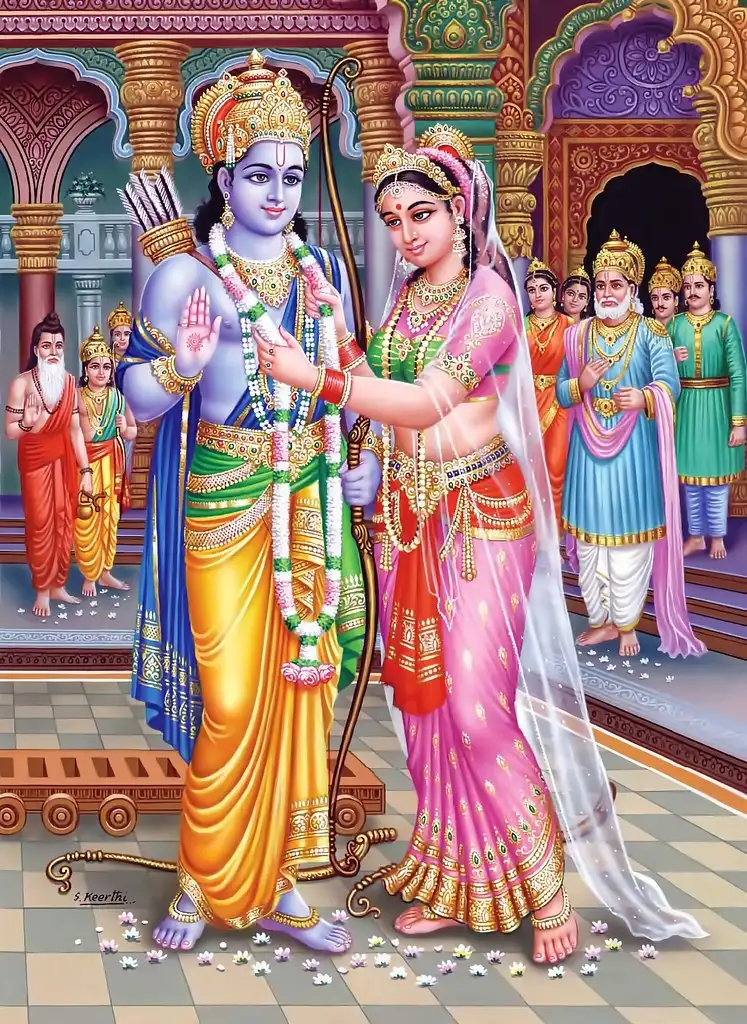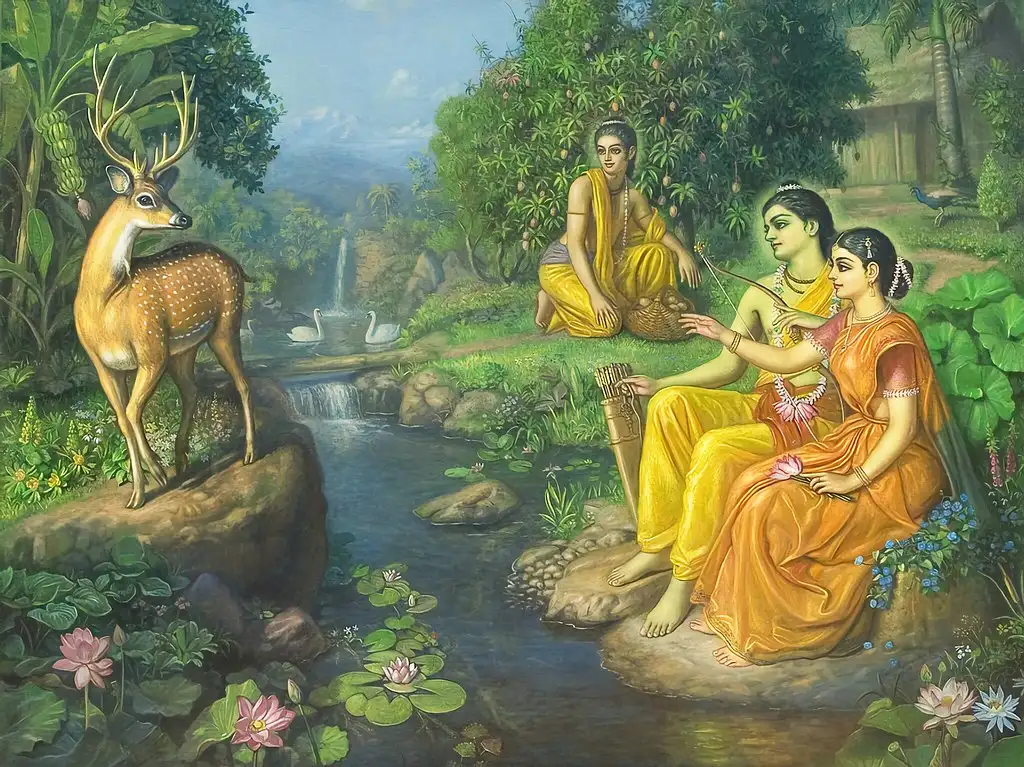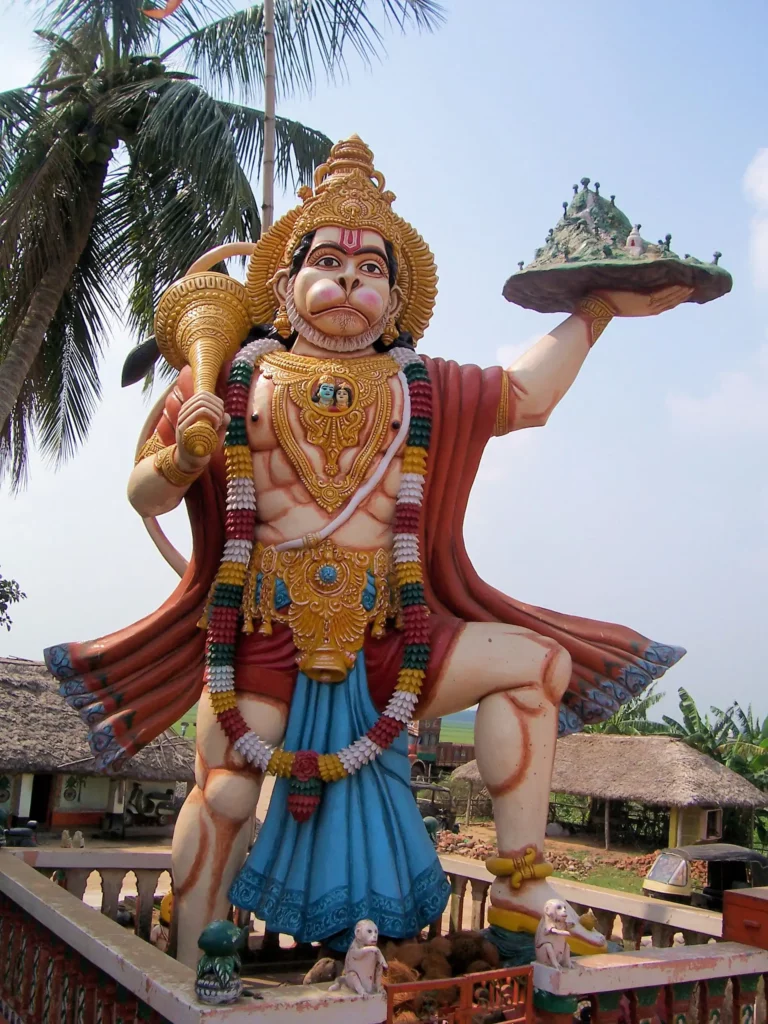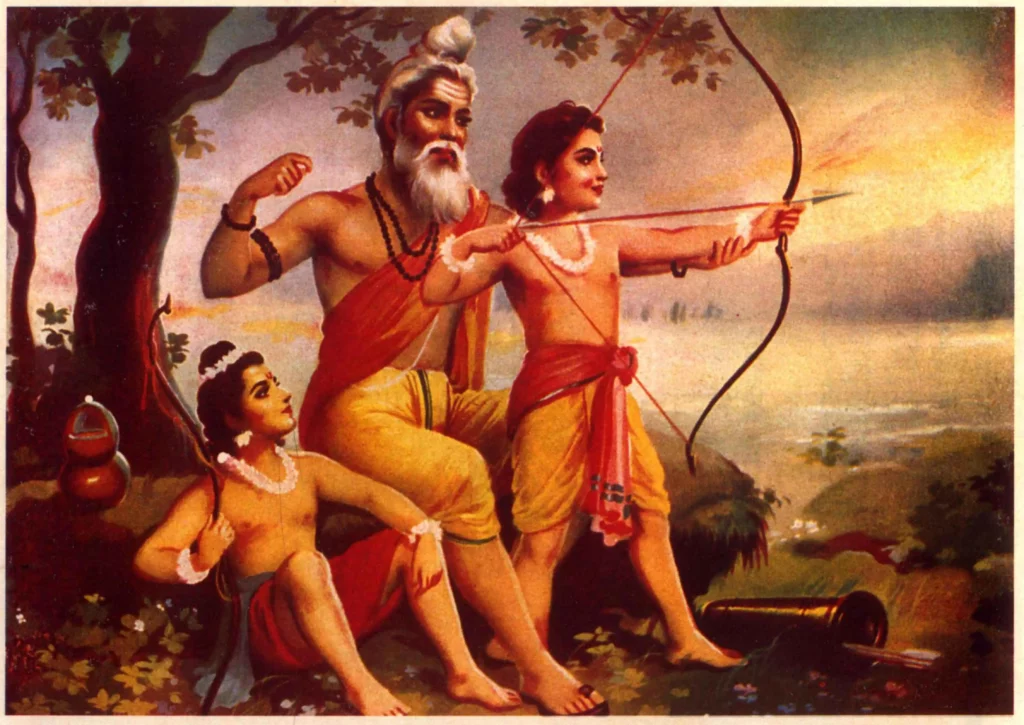The legend of Sri Rama and his wife Sita is etched into the hearts of millions of people who have heard the legend of the Ramayana. Written by Valmiki around the 6th century BCE, The Ramayana is one of the sacred texts of Hinduism highlighting the life of the prince of Ayodhya, Lord Rama. Ramayana spans over 24000 verses and is often considered the first poem to ever be written.
The Ramayana depicts true goodness in mankind in the form of Rama and his followers. It sends the message that in the battle against good and evil, good always triumphs. Filled with elements of magic, fantasy, and imagination, the Ramayana is the textual personification of purity.
The Ramayana is divided into six sections or kandas: Balakanda, the first section depicting Rama’s childhood; Ayodhya Kanda, the second section explaining Rama’s marriage to Sita and his exile into the forest; Aranya Kanda, illustrating the abduction of Sita by Ravana; Kishkinda Kanda, the fourth section highlighting Rama’s journey to Kishkinda and his encounter with Hanuman; Sundara Kanda, the story of Hanuman’s journey to Lanka in search of Sita and finally the Yuddha Kanda, the war between the armies of Rama and Ravana.
Unlike the Mahabharata, which depicted the flaws in humanity, the Ramayana is meant to establish hope in mankind. Every Kanda of the epic sends across a powerful message. The Ramayana teaches us that even during the most difficult times, one must never stray away from dharma and have faith in the justice of God.
The Prelude
The story of the Ramayana began in the Kingdom of Ayodhya where the noble King Dasharatha was having trouble begetting a child, desperate Dasharatha and his three wives Kaushalya, Kaikeyi and Sumitra decided to conduct the Putra Kameshti Yajna (Putra =son; Kameshti= an object of desire), a fire ceremony that aided the birth of a son.
The Birth of Rama and Three other princes
From the ceremonial fire, appeared Agni, the fire god. He gave the king a golden vessel containing magical nectar that would lead to the birth of his sons. The king, overcome by joy, handed the nectar to his wives, all of whom gave birth shortly thereafter.
The eldest queen, Kaushalya gave birth to Rama – the protagonist of the epic. The second queen Sumitra gave birth to twins Lakshmana and Shatrughna and the third queen Kaikeyi gave birth to Bharat.

(Public Domain)
Early Life of Rama
Growing up, the four princes of Ayodhya were inseparable. Under the training of Guru Vashishtha, the children grew up to be virtuous and noble princes, all worthy of the title of King. However, of the four of them, it was Rama who stood out. The eldest prince possessed wisdom beyond his years and was kind to everyone around him. The young prince’s wisdom and righteousness were truly beyond his age and the people of Ayodhya truly adored him. It is believed that Rama was the embodiment of the supreme Lord Vishnu, sent to earth, to defeat the demon Ravana.
The twins of Sumitra, Lakshmana and Shatrughna had each been instructed by their mother to take care of their elder brothers. Lakshmana made it his duty to stay with Rama, whereas Shatrughna remained alongside Bharat.
Rama and Lakshmana’s Quest with Vishwamitra
The arrival of the learned sage Vishwamitra in Ayodhya marked the beginning of an important phase in the lives of the princes. The sage visited the king and requested the service of his sons. The pious rishi went on to explain that his Ashram was being attacked by asuras and he would require the assistance of the princes to get rid of them. Dasharatha appointed Rama and Lakshamana to help the rishi fight the asuras.
It is believed that Vishwamitra sensed Lord Vishnu’s presence in Rama and wanted to confirm whether the prince of Ayodhya was truly so divine. Therefore, of all the kingdoms in the country, the learned sage chose to go to Ayodhya.
The young princes, barely at the cusp of manhood, accompanied guru Vishwamitra to his ashram. Both Rama and Lakshamana, armed with the special weapons provided by Vishwamitra’s disciples, fought and defeated the Asura Tataka and his minions. Pleased with their courage and devotion, Vishwamitra asked the boys to accompany him to the Kingdom of Mithila.
Rama Marries Sita
Along with Vishwamitra, the princes traveled to Mithila, a kingdom renowned for its spiritual and academic importance. For several months, the kingdom was in a state of celebration. The wise King Janaka was in search of a groom for her daughter, princess Sita.
Sita was a noble child, excelling in academics and always aiding her father in matters of the state. The king was determined to marry off his daughter to the most virtuous man in the country. Therefore, he devised an extremely difficult task for the swayamvar and invited kings and princes from all over the country to participate.
The challenge required the participants to string up the Pinaka – the holy bow of Lord Shiva, a bow possessing an unimaginable amount of tensile strength.
King Janaka was devastated and worried when not a single participant had managed to lift the bow and forget about stringing.
That’s when Sage Vishwamitra suggested that Rama should participate in the swayamvar. The dutiful prince did not question the guru and approached the bow. Unlike any of the other competitors, Rama wielded the bow with incredible ease and while stringing it, he used such an immense amount of power, that the bow snapped. The twang of the broken bow sent tremors across the land and people rushed to the ceremony hall to witness the commotion. When the dust settled, it was observed that right before the bow had snapped, Rama had strung it, rightfully winning Sita’s hand in marriage.
As Rama got married to Sita, Lakshamana was married to Sita’s sister Urmila and the newlywed couples returned to Ayodhya.

(Public Domain)
Rama Coronation
As the princes reached manhood, it was evident to Dasharatha that Rama would be his successor to the throne. The eldest prince had demonstrated virtue, strength, patience, and loyalty. Everyone in the kingdom loved and respected Rama, making him the ideal choice.
Therefore, when Dasharatha grew old, he decided to step down from the throne and hand over the kingdom to his son. Everyone in the kingdom, right from the ministers to the peasants were eager to welcome Rama as the king of Ayodhya and wholeheartedly agreed with the king’s decision.
The Exile
While everyone seemed to be happy with this decision, there was one person who could not bear the thought of Rama becoming king. The king’s youngest wife Kaikeyi wanted her son Bharat to assume the throne.
She approached the king and invoked a promise he had made to her years ago. He had promised her that he would fulfill two of her wishes regardless of their magnitude and nature. Kaikeyi asked the king to banish Rama from the kingdom for 14 years and appoint Bharat as the King of Ayodhya.
The king was heartbroken as he explained his situation to Rama. To his immense surprise, the eldest prince accepted the exile with grace and calm, without questioning his father’s judgment.
Therefore Prince Rama, along with his wife Sita and brother Lakshamana, made his way into the forest to live in exile for fourteen years. The whole kingdom watched in disappointment as their favorite prince departed towards the forest.
Bharat Milap: Loyal Bharat Meets Rama
Bharat was oblivious to the events that had transpired in his absence. When the young prince returned from his uncle’s house, he was appalled by the actions of his mother. The loyal brother rushed into the forest and begged Rama to return. Rama, however, was obstinate and was determined to fulfill his father’s promise.
The dejected Bharat returned to the palace and placed Rama’s slippers on the throne. He went on to rule the kingdom in the name of Rama, much to Kaikeya’s disappointment. Soon after Rama’s departure, the aging Dasharatha, unable to bear the grief of his son’s punishment, passed away.
Surpanakha’s Encounter with Rama, Sita and Lakshmana
For thirteen years, the trio led extremely simple lives, devoid of any luxury. For the Rama, the company of his wife and brother meant everything. Over the course of their exile, Rama, Sita, and Lakshmana traveled southwards along the banks of the river Godavari.
During their stay in the Panchavati forest, the trio encountered Surpanakha, the demoness. Surpanakha was the sister of the demon king Ravana, the King of Lanka. The second the demon princess laid her eyes on Rama, she was blown off her feet. Surpanakha approached Rama and asked him to marry her.
The dutiful Rama politely denied and asked Surpanakha to consider his brother instead. Surpanakha, a bit dejected approached Lakshamana, hoping to find a husband. Lakshmana too rejected Surpanakha’s proposal stating that he had taken up a temporary vow of celibacy. He asked Surpanakha to go back to Rama, and the hopeful demoness was quick to trust him.
After being rejected by Rama again, Surpanakha could not suppress her anger. She tried to kill Sita hoping that, following the death of his wife, Rama would consider marrying her. As soon as she attacked Sita, Lakshmana stepped in and cut off her nose and ears. The embarrassed Surpanakha rushed back to Lanka where her brother Ravana was furious at the way she had been treated.
Sita Haran: Ravana Abducts Sita
Surpanakha’s defacement was not taken lightly by Ravana. His sister had been insulted and he would not rest until Rama and Lakshmana had suffered. With the help of the demon Maricha, Ravana created an intricate plan to abduct Sita.
Maricha assumed the form of a golden deer and wandered near the dwelling of Rama and Sita. The princess of Mithila, upon seeing the beautiful deer, requested her husband to get it for her. Rama, well aware that this was a ploy by the demons, sets out to find the deer, leaving Lakshmana to guard Sita.

(Public Domain)
Rama chased after Marchia for a while and ultimately caught up with him. He fired an arrow straight into the deer and as the disguised demon took his last breath, he let out a blood-curdling scream calling out Sita’s name.
The Lakshmana Rekha
Back at the cottage, the scream let out by Maricha alarmed Sita beyond measure. She begged Lakshamana to go check on his brother. Despite Lakshmana’s assurance, Sita was convinced that Rama was in danger. Nevertheless, Sita’s insistence knew no bounds, and Lakshmana decided to fulfill his sister-in-law’s request.
Before leaving Lakshamana, sprinkled chalk around the cottage and cast a spell, preventing demons from entering the cottage. This boundary drawn by Lakshamana is popularly referred to as the Lakshmana Rekha. With both the brothers away, Sita waited in patience for them to return.
While Sita was waiting alone in the cottage, Ravana appeared in front of her in the form of an ascetic begging for alms. The generous princess, unaware of the looming danger, stepped out of the Lakshmana Rekha. The demon Ravana saw his opportunity and abducted Sita. As the princes were returning to the cottage, they witnessed Ravana’s flying saucer, the Pushpaka Vimana carrying away Sita into the sky.
As the princes followed the Vimana, they encountered Jatayu, the vulture. Jatayu had heard Sita’s cries of help and rushed to the spot to help her. In his battle against Ravana, the vulture lost his wings and was slowly bleeding to death by the time Rama and Lakshmana arrived. The vulture advised the princes to go to the Kingdom of Kishkinda and consult the monkey king.
The Search for Sita Starts
The abduction of Sita had a traumatic effect on Rama. The otherwise calm and sensible prince was now in disarray. Along with Lakshmana, he made his way towards the kingdom of Kishkindha, hoping to receive help from the monkey residents.
Rama Meets Hanuman
On their way, the duo was introduced to Hanuman, one of the greatest ape heroes of the kingdom and a staunch devotee of Rama. Hanuman was a supporter of Sugriva, the younger brother of the tyrant king of Kishkindha, Vali. Hanuman and Sugriva, along with a few other apes, wanted to get rid of Vali but were no match for his strength.
Under the circumstances, Rama and Sugriva struck up a deal. Rama would help Sugriva kill his brother and in turn, as the King of Kishkina, Sugriva would provide Rama with all the resources necessary to find Sita.
Vali and Sugriva
Thus the two princes devised a plan to get rid of Vali. Sugriva would challenge his brother for the throne in a duel, and while the two brothers battled it out, Rama would shoot an arrow at Vali, killing him in the process. The plan was executed with perfection and Sugriva regained the kingdom of Kishkinda.
However, due to his newfound powers, Sugriva had forgotten about Rama’s request. He was busy exercising his rights as king, until Lakshmana, furious at his negligence, decided to destroy Sugriva’s palace. The monkey king apologized for his indolent behavior and sent out search parties across the world, to locate Sita and Ravana.
The monkeys sent to the North, East, and the West reported no news. Finally, it was Angada and Hanuman, who had traveled south and encountered Jatayu’s brother, Sampati, who delivered information regarding Sita’s whereabouts. Sampati claimed that Sita was being held hostage in the Kingdom of Lanka, an island beyond the southern seas.
The Search for Sita Ends
On hearing the news, Rama sent Hanuman to Lanka to confirm this information. After swimming through the ocean for days, the mighty ape arrived at Ravana’s Kingdom. He explored the island and observed the demons, until finally, he found Sita in Ashoka Vatika (grove), sitting in silence.
He approached the woeful princess and explained that he had been sent by Rama. Sita did not believe him at first and dismissed it as one of Ravana’s ploys. Hanuman then showed Sita a ring Rama had given him, which made Sita realize that Hanuman was in fact Rama’s messenger. The great ape asked Sita to wait in patience as Rama would soon arrive. He then proceeded to wreak havoc on Lanka.
Soon, the news of a monstrous monkey destroying Lanka reached Ravana’s ears. He sent his son to capture Hanuman. Ravana’s son Megnatha shot the Bhramastra at Hanuman, the divine weapon of the god Brahma. Hanuman, not wanting to disrespect the gods, surrendered to the Bhramhastra and was captured.
In the royal court of Lanka, Ravana was furious. He eyed the notorious monkey and asked him what he wanted. Hanuman revealed the true intention of his visit and gave Ravana a final warning. He asked the demon king to let go of Sita and accept Rama’s apology before a war ensued. The proud Ravana was insulted by the proposition and decided to punish Hanuman by beheading him.
Ravana’s younger brother Vibhishana interjected and advised his brother that killing a messenger is a grave sin. Instead, they should set his tail on fire. Eager to cause Hanuman pain, Ravana agreed.
Lanka Dahan: Hanuman Burns Down the Golden Lanka
A huge amount of clothing was ordered to cover Hanuman’s tail but to play with the demons of Lanka, the magical ape slowly grew his tale. Soon every piece of cloth in the kingdom of Lanka was used to cover Hanuman’s tail and the whole thing was torched.
To the immense shock of all the ministers and Ravana, Hanuman was unfazed by the fire on his tail. Instead, he grew to magnanimous proportions and jumped around the entire kingdom, setting it on fire. The demons of Lanka watched in awe and fear as a giant ape torched their entire city. With Lanka burning, Hanuman decided to return to Rama and tell him about his interaction with Sita.
The Rescue for Sita Starts
With Sita’s whereabouts confirmed, Rama along with Sugriva and his army of monkeys decided it’s time to end Ravana once and for all. They arrived at the ocean and requested the ocean god to grant them access to Lanka. The divine ocean deity appeared before Rama and informed him that rocks containing his name would float on water, allowing them to make a bridge to the other side.
Soon, all the subjects of Sugriva gathered a ton of rocks and started inscribing Shri Rama’s name on them. With the help of two monkeys, in particular, Nala and Nila, the entire entourage was able to cross the ocean on a bridge made out of floating rocks.
After they arrived in Lanka, Rama tried to negotiate with Ravana for one last time. He sent Angada as his messenger hoping to prevent the war and settle matters peacefully.
Rama’s Last Resort to Avoid the War
Angada was not welcomed at Ravana’s court. The demon king had had his share of notorious monkey messengers and was in no mood to entertain Angada. He ordered his guards to throw the ape warrior out of his court. The messenger, however, had no intentions of leaving. The guards of the palace were unable to move Angada’s leg as he stood there with both his feet planted firmly on the ground. Finally, Ravana himself came forward to move the monkey’s legs to which Angada stepped away. He said, “The only person’s feet you need to fall on are that of Lord Rama’s”. With that, he flew off to the rest of his army.
The War
Rama had decided that it was time for battle. After multiple attempts at peaceful negotiations, the prince of Ayodhya had no other choice. The following morning at dawn, the Vanara Sena (monkey army), opened the attack on Lanka.
Countless demons and innumerable monkeys perished in a devastating war that lasted seven days.
Lakshmana vs Indrajit
Indrajit (also known as Meghanada) was the greatest and the most furious warrior on Ravana’s side after Ravana himself. He was a great archer and unsurpassed grandmaster in illusion warfare techniques.
He was a fierce warrior who swiftly wiped out the vanara army, That’s when a deadly battle broke out between Lakshmana and Ravana’s son, Indrajit.
Indrajit used all his force and supreme magical power ‘Vasavi Sakthi’ Against Lakshmana which gravely wounded him and required immediate medical attention.
Hanuman: The Saviour
A distraught Hanuman brought the young prince to Rama, who was shaken up at the prospect of losing his brother. After consulting the royal physician of Lanka, it was discovered that there was only one plant that could cure Lakshmana’s condition. It was the Sanjeevini Booti that was found only on Mount Sumeru in the Himalayan Range.
Hanuman could not stand to witness Rama in such pain and flew off towards the Himalayas to find the medicinal herb. On his arrival, however, the great ape was unable to recognize the plant. Eager to help Lakshmana as soon as possible, Hanuman picked up the entire mountain on his arm and carried it all the way back to Lanka.

(Public Domain)
With the entire mountain at his disposal, the physician created the cure for Lakshmana and the prince lived to defeat Indrajit.
Kumbhkaran: The Giant Demon
The battle continued again and Ravana could sense the Vanara Sena overpowering his army. Seeing no other option, the demon king decided to bring in the strongest warrior in Lanka, his brother Kumbhkarana.
Kumbhkarana was a demon of monstrous proportions. He ate for six months and slept for the remaining year. The demon was extremely loyal to his brother and agreed to fight in the war, despite being woken up from his sleep.
On the next day of the war, Kumbhkaraba wreaked havoc on Rama’s army. He killed thousands at a time and none seemed to match his strength. Finally, Lord Rama himself battled the gigantic monster and slew him in battle.
The loss of his brother was the last straw for Ravana. With the blessing of Lord Shiva, the demon king approached the battleground to avenge the death of his loved ones.
Rama vs Ravana
A legendary battle was fought between Rama and Ravana. The devatas from the heavens sent their aid to Rama, but the might of Ravana could not be matched. Blessed with immortality, the demon was impervious to Rama’s attacks. Ultimately, it was Ravana’s brother Vibhishana, who had joined Rama before the war, who revealed Ravana’s weak spot.
The Death of Mighty Ravana
Heeding Vibhishana’s advice, Rama fired an arrow at Ravana’s navel, the only vulnerable spot on his body. The mighty demon king perished in battle as Rama and the Vanara Sena emerged victoriously. With Ravana’s death, an era of evil and Adharma had come to an end. Lord Vishnu in the form of Sri Rama had restored the balance between Good and Evil and established the presence of dharma in the society.
Agni Pariksha: Sita’s Trial by Fire
After defeating Ravana, the entire army of Rama was in a state of jubilation. Vibhishana was declared King of Lanka and his first official act as king was to respectfully release Sita.
The separated couple was all set to meet each other after twelve long months, but Rama was a bit anxious. Sita had lived in Lanka for almost a year, such a long duration in the kingdom of Ravana made Rama question Sita’s purity. While Rama the husband was anxious to meet his wife, Rama the king of Ayodhya had to make sure that all the rules were followed.
Before conjoining, Rama asked Sita to undergo trial by fire and prove her chastity. The shocked audience watched, as Sita stepped into red hot flames that melted away even her gold jewelry. From the fire, the queen emerged unharmed thereby proving her purity to Rama.
Rama Returns to Ayodhya
Soon after the conclusion of the war, the entire entourage returned to Ayodhya. The residents of the kingdom were delighted to see their king return and hosted a grand celebration to mark his victory. People across Ayodhya, lit up diyas and candles signifying the triumph of light over darkness.
After greeting Bharata and Shatrughna, Rama rightfully assumed the throne of Ayodhya. The years that followed were known as the period of ‘Ram-Rajya.’ It was a time of utmost peace and prosperity. No citizen of Ayodhya, went to bed hungry and crime rates dropped to zero. Under Rama, Ayodhya had become the greatest kingdom in the country.
Uttara Khanda: The Story Post-War
The original Ramayana written by Valmiki was divided into six parts and concluded with Rama becoming king of Ayodhya. There is, however, a seventh part of the story called the Uttara Ramayana (post-Ramayana).
For many years, Rama ruled Ayodhya to the best of his abilities. With Sita as his queen, the kingdom of Ayodhya flourished. Unfortunately, this period of happiness between the royal couple did not last forever.
Rumors regarding the purity of Sita started to spread amongst the common folk of Ayodhya. For the disciplinarian in Rama, this was unacceptable. Initially, he tried to ignore them but soon, these rumors got into his head. The king of Ayodhya who was often considered the ideal husband started questioning his wife’s chastity.
The Banishment of Sita
Ridden with doubt, Rama asked Sita to undergo the agnipariksha (trial by fire) yet again. The queen was insulted by the lack of faith portrayed by Rama and refused to undergo the trial. Having no other choice, Rama banished Sita from Ayodhya. He tasked Lakshmana with the job of ensuring Sita left the kingdom. With a heavy heart, the obedient Lakshmana escorted his sister-in-law to the forest and abandoned her there.
The Birth of Luv and Kush
The distraught Sita wandered for days before arriving at the ashram of the sage Valmiki, who also happened to be the author of the Ramayana. The sage provided shelter to the former queen of Ayodhya and took care of her every need. After her arrival, it was discovered that Sita was pregnant. Soon, she gave birth to twin boys named Luv and Kush.

(Public Domain)
Under the tutelage of Valmiki, the two princes grew up to be young virtuous boys possessing many qualities of their father. Both the brothers were excellent warriors even at a young age, possessing knowledge of weapons that took years of mastering.
The Ashwamedha Yagna
On one eventful day, the brothers were playing in the forest, when they came across a beautiful horse. The forehead of the horse was inscribed with a message stating that whoever tied the horse will have to face the wrath of King Rama’s army. The young brothers were unable to decode that the horse had been sent by Sri Rama, to successfully conduct the Ashwamedha Yagna.
As Luv and Kush sat by the horse, the army of Ayodhya led by Shatrughna arrived at the forest. The chief of Ayodhya’s army warned his nephews regarding the consequences of their actions and advised them to let the horse go. The brave twins, however, had other plans in mind.
The two young boys fought with the entire army of Ayodhya and defeated them. In the process, they captured Hanuman and brought him home to boast their victory to their mother. When Sita witnessed her sons dragging her most loyal devotee, she was shocked.
The Twins Learn the Ramayana
She instructed the boys to let Hanuman go and decided it was time to tell them the story of the Ramayana. Valmiki, who had by then composed the epic poem, read it out to the twins, explaining their true heritage. Hanuman who was truly impressed by the skill and valor of his lord Rama’s sons suggested a plan to get the king’s attention.
Very soon, both the boys mastered the Ramayana and sang it beautifully. Hanumana asked them to sing the poem, in the kingdom of Ayodhya, in front of the common people.
The Grand Reunion Turned Sore
Soon the tale of two young boys singing the story of King Rama spread across the kingdom of Ayodhya. After a little while, Rama himself was curious about the two twins. He called them to his court, eager to view their talents.
Luv and Kush sang the Ramayana in front of their truly impressed father. But immediately after that, Sita arrived at the court. Rama realized that Luv and Kush were his sons and his eyes filled up with tears.
The End of Sita
Nevertheless, as dutiful king of Ayodhya, he could not invite Sita back as queen in front of all his ministers. With a heavy heart, he asked Sita yet again to prove her purity.
For the Queen, that was the last straw. In her anger, she screamed that if she was pure, the earth would open up and swallow her.
The very next second the earth cracked open and swallowed Sita up. Despite rumors surrounding her chastity, Sita had given the ultimate proof of her loyalty and devotion to Rama.
The End of Rama
With Sita’s return to the earth, Rama decided it was time for him to abdicate the throne. After coronating Luv and Kush as the rulers of Ayodhya, Rama along with his brothers traveled to the river Sarayu and departed from their human form.
Rama assumed his true form as Vishnu as he returned to the heavens. Waiting for him, in the divine land of Vaikuntha, was his wife, Sita, in her true form as the goddess Lakshmi.
The Legacy of the Ramayana
Over the years, the Ramayana has been retold countless times, with multiple versions surfacing in different parts of the country. Despite regional variations, the Ramayana has connected the people of India, and the incredible tale of Rama is considered a true example of heroism.
Apart from the literary value of the text, many events from the Ramayana are celebrated even today. The death of Ravana is celebrated as Dussehra, The return of Rama and Sita to Ayodhya is celebrated as Diwali, where people honor Lord Rama’s victory and burn diyas to commemorate the triumph of good over evil. The festivals of Dussehra and Diwali are also accompanied by stage plays of the Ramayana called Ram-Leela. Actors dress up as the characters of the epic and present the entire Ramayana in front of a grand audience.
As the admiration surrounding such stage plays increased, the Ramayana was adapted into numerous movies and TV shows. Stories of Rama’s bravery, Hanuman’s loyalty, and Sita’s devotion were viewed and adored by millions of people ranging from children to the elderly.
The popularity of the epic exceeds Indian borders, with different versions of the Ramayana being told in countries such as Cambodia, Indonesia, and the Philippines. Reamker and Ramakavaca, as the epic is called in Cambodia and Indonesia respectively, talk about the story of Rama as he maintains the balance between good and evil in the world.
The staggering acclaim received by the Ramayana can be attributed to the lessons taught by the characters. The nature of the story is such that it restores faith in humanity. It gives people hope that it is possible to be as virtuous as Rama, as loyal as Hanuman, and as pure as Sita. The story helps people realize that at the end of every dark tunnel, there is light and that for every instance of evil in the world there is good.


